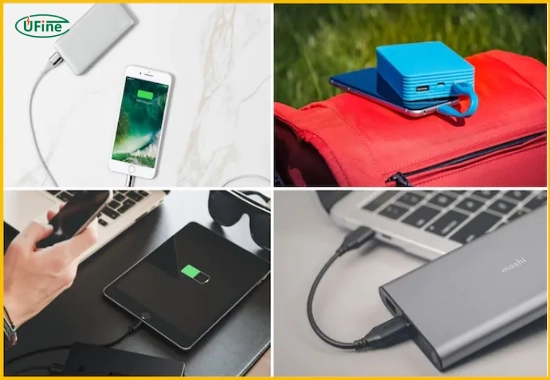When it comes to staying powered up on the go, understanding the difference between an external battery and a power bank is essential. Both portable charging solutions offer convenience but serve different purposes and have unique features. This article will delve into the distinctions between external batteries and power banks, helping you determine which option best fits your lifestyle and charging needs.
Part 1. What is an external battery?
An external battery is a portable power source that provides additional energy to various devices, including smartphones, tablets, and laptops. These batteries are typically rechargeable and come in different sizes and capacities, allowing users to select one that meets their needs. External batteries are handy when access to wall outlets is limited or unavailable.
Types of Batteries Used in External Batteries
The most common types of batteries found in external batteries include:
- Lithium-Ion (Li-ion) Batteries: These are the most prevalent type used in external batteries due to their high energy density and efficiency. They can store significant energy relative to their size, making them ideal for portable applications. A lithium-ion external battery may range from 5,000 mAh to 30,000 mAh or more, allowing for multiple device charges.
- Lithium Polymer (LiPo) Batteries: These batteries are another popular choice for external batteries. They offer a thinner and lighter design than Li-ion batteries, which can be advantageous for ultra-portable devices. However, they may have slightly lower energy density than Li-ion batteries.
- Lithium Iron Phosphate (LiFePO4) Batteries: Known for their stability and safety, LiFePO4 batteries are less common in consumer-grade external batteries but are valued for their long cycle life and thermal stability. They are often used in applications where safety is a primary concern.
Key Features of External Batteries
- Capacity: Measured in milliampere-hours (mAh), the capacity indicates how much energy the battery can store. For example, a 10,000 mAh external battery can typically fully charge most smartphones at least two times.
- Output Voltage: Most external batteries provide a standard output voltage of 5V for charging USB devices; however, some models can offer higher voltages (like 12V) for laptops or larger devices.
- Size and Portability: External batteries vary significantly in size and weight. Some are compact enough to fit in your pocket, while others may be larger and heavier but offer greater capacity.
Part 2. What is a power bank?
A power bank is a specific type of external battery designed primarily for charging portable electronic devices. Power banks usually feature one or more USB ports and are commonly used to charge smartphones, tablets, and other gadgets while on the move.
Types of Batteries Used in Power Banks
Power banks predominantly use the following types of batteries:
- Lithium-Ion (Li-ion) Batteries: Like external batteries, many power banks utilize Li-ion technology due to its high energy density and efficiency. A typical power bank may range from 2,000 mAh to over 30,000 mAh in capacity.
- Lithium Polymer (LiPo) Batteries: Power banks may also use LiPo batteries for their lightweight and slim profile, making them ideal for portable designs.
Key Features of Power Banks
- Multiple Ports: Many power banks come equipped with numerous USB ports, allowing you to charge several devices simultaneously without needing additional chargers.
- Smart Charging Technology: Some modern power banks feature innovative charging technology that detects the optimal charging speed for connected devices, ensuring efficient energy transfer.
- LED Indicators: Most power banks include LED lights that indicate the remaining battery life, allowing you to gauge when to recharge.
Part 3. How do external batteries and power banks differ?
While both external batteries and power banks serve the purpose of providing portable power, they have distinct characteristics that set them apart:
External batteries are generally more versatile than power banks. Due to their multiple output options, they can charge various devices. For example, many external batteries can power smartphones, laptops, and other electronics requiring different voltage levels.
In contrast, power banks are designed explicitly for smaller electronic devices such as smartphones and tablets. They usually have built-in features like multiple USB ports for simultaneous charging but may need more versatility for larger devices.
Comparison Table
| Feature | External Battery | Power Bank |
|---|---|---|
| Purpose | General portable energy source | Specifically for charging devices |
| Device Compatibility | Supports various electronics (smartphones, tablets, laptops) | Primarily for smartphones/tablets |
| Capacity Range | Typically ranges from 5,000 mAh to 30,000 mAh or more | Usually ranges from 2,000 mAh to 30,000 mAh |
| Output Voltage | Can vary (5V for USB; higher for laptops) | Usually 5V; some support higher voltages |
| Size | Varies widely; can be compact or bulky | Generally compact and lightweight |
| Smart Features | Less common | More common (smart charging) |
Which one should you choose?
Choosing between an external battery and a power bank largely depends on your specific needs:
- An external battery may be your best bet if you need something versatile to charge multiple devices (like laptops).
- A power bank with multiple USB ports might be more suitable if you primarily charge smartphones or tablets while on the go.
Part 4. Common misconceptions about external batteries and power banks
There are several misconceptions surrounding external batteries and power banks:
- All external batteries are heavy: While some may be larger, many modern designs prioritize portability without sacrificing capacity.
- Power banks can’t charge laptops: Some high-capacity power banks are designed explicitly for this purpose and can effectively charge laptops and smaller devices.
- External batteries don’t have smart features: Many modern external batteries come equipped with smart technology similar to power banks.
Part 5. Choosing the right product for your needs
When deciding between an external battery and a power bank, consider several factors:
- Device Compatibility: Ensure that your chosen product is compatible with your devices. An external battery may be more suitable if your laptop requires higher voltage or specific connectors.
- Capacity Requirements: Assess your typical charge needs based on your usage patterns. If you’re often away from outlets for extended periods or use power-hungry devices like laptops, look for higher-capacity options.
- Portability Needs: If you frequently move or travel light, prioritize lightweight options that easily fit into your bag or pocket.
Part 6. FAQs
-
What should I look for when buying a portable charger?
When purchasing a portable charger, consider factors such as capacity (mAh), Compatibility with your devices, size and weight for portability, number of output ports, and whether it includes smart charging technology. -
Can I use an external battery to charge my smartphone?
Yes! An external battery can charge smartphones with the appropriate output voltage (usually 5V) and connector type (like USB). -
How long does it take to charge an external battery or power bank?
Charging times vary based on capacity and input specifications but generally range from 4 to 8 hours for full charges using standard outlets. Higher-capacity models may take longer. -
Are there safety concerns associated with using these products?
As with any electronic device, safety concerns include overheating or short-circuiting. Always choose products from reputable brands that include safety features like overcharge protection. -
Can I bring an external battery or power bank on an airplane?
Yes! Most airlines allow passengers to carry portable chargers on board; however, there may be restrictions on capacity (usually over 100Wh requires airline approval). Always check with your airline before traveling.
Related Tags:
More Articles

Aluminum Air Battery Design: Materials, Assembly & Efficiency Tips
An aluminum air battery uses aluminum and air to generate power. Learn its materials, assembly steps, and tips to boost energy output and efficiency.
7 Advantages of a Heated Lithium Battery in Cold Climates
Looking to power batteries in freezing temps? Heated lithium batteries excel in cold climates. Here are 7 key benefits and how they work.
How to Choose the Best Floor Scrubber Battery for Commercial Cleaning?
Selecting the ideal floor scrubber battery ensures a long runtime, rapid charging, and minimal maintenance for efficient commercial cleaning operations.
Battery for Blower vs Battery for Leaf Vacuum: Which One Should You Choose?
Battery for blower vs leaf vacuum—learn the key differences in power, fit, and runtime to choose the right battery for your outdoor tool needs.
How to Choose the Right Battery for Blower?
Choosing the right blower battery? Consider voltage, capacity, chemistry & usage. This guide helps match the best battery for peak performance.





